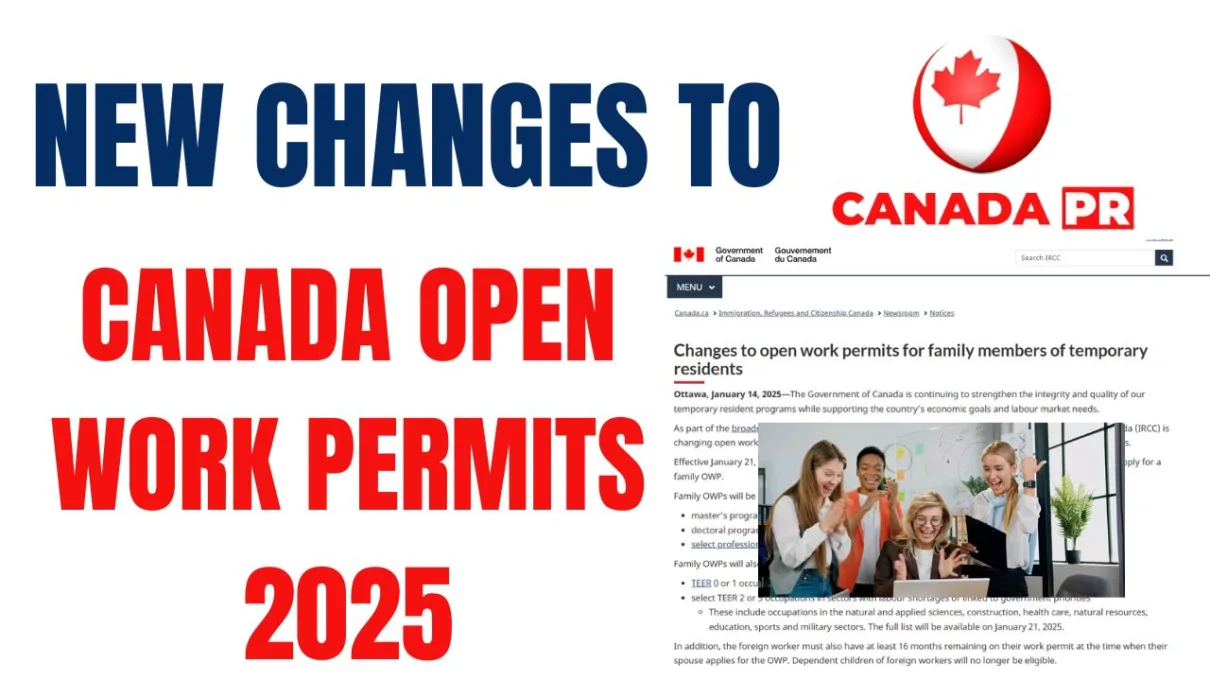New Changes to Canada Open Work Permits 2025: Canada has emerged as a primary destination for international workers seeking entry into one of the most welcoming nations globally. This system not only benefits employers by addressing labor shortages and sourcing specialized skills but also enhances the overall workforce. The period of 2024-25 will witness significant updates to the work permit framework, with key components reflecting Canada’s evolving economic and social priorities.
This article will elucidate the major changes, their implications, and essential information for both employers and employees. The Canadian Work Permits 2025 initiative has been introduced, positioning Canada as a secure and attractive environment for both skilled and unskilled foreign workers over the past decade. Canadian organizations are now offering competitive wages and incentives to individuals, whether they are foreign nationals or permanent residents.
New Changes to Canada Open Work Permits 2025
The revised Canada Work Permit Policy aims to manage labor shortages effectively while providing a safer working environment for foreign workers. Additionally, it seeks to maintain a straightforward and efficient immigration process. This article will outline the key modifications to the Canada Work Permits 2025, their potential impacts, and the strategies Canadian organizations will employ to implement these changes.
| Title | Canada Work Permit 2025 major Changes |
| Country | Canada |
| Changes Applicable from | Jan-25 |
| Purpose | Streamline the Permit Process Reduce the Exploitation |
| Official Website | canada.ca |
When will the $1702 stimulus check be issued in 2025? Important Dates to Remember
Significant Modifications to Canadian Work Permit Regulations
In light of the critical amendments outlined above regarding the regulations governing work permits in Canada, the following alterations have been implemented.
1. Optimized Application Procedure: The government has launched an efficient online system for work permit applications, which is anticipated to accelerate processing times by 30 percent. This initiative aims to alleviate the burdens faced by both employers and applicants. The optimized process also features enhanced document verification and real-time tracking of application statuses.
2. Broadened Scope of Occupation-Specific Work Permits: Recent regulations emphasize sectors experiencing high demand, such as healthcare, information technology, and construction. The expanded lists of eligible occupations under the Global Talent Stream and the Temporary Foreign Worker Programme (TFWP) facilitate expedited processing for critical roles.
3. Strengthened Compliance Obligations for Employers: Employers who recruit foreign workers through the work permit system will likely encounter more rigorous compliance audits. They will be required to demonstrate their efforts in hiring local talent, among other obligations, to ensure adherence to fair labor standards. The government has increased penalties for non-compliance, reinforcing its commitment to safeguarding workers’ rights.
4. Expanded Open Work Permit Opportunities for Families: In an effort to promote family unity, Canada has broadened the eligibility criteria for open work permits for the spouses and dependents of temporary foreign workers, which is expected to draw skilled individuals to the nation.
5. Work Permit Duration and Pathways to Permanent Residency: The extension of certain work permits is designed to enhance stability for workers, while also streamlining the routes to permanent residency, particularly for those engaged in essential sectors and residing in rural areas.
6. Industry-Specific Initiatives
In response to labor shortages in two critical sectors, targeted initiatives will be introduced to enhance employment opportunities:
Healthcare Sector: The Canadian Work Permit for 2024-25 is designed to bolster employment within the healthcare sector. This initiative aims to attract more nurses, physicians, and various healthcare practitioners.
Technology Talent Initiative: This program emphasizes the Global Talent Stream, facilitating the recruitment of technology professionals and offering significant advantages, such as visa entry exemptions for short-term relocations.
Who is receiving missed IRS stimulus checks from the Internal Revenue Service, and why?
Canada’s New Open Work Permit Rules: Everything You Need to Know?
What Actions Should Employers Take Following the Implementation of Canadian Work Permits 2025?
In light of the changes introduced by Canadian Work Permits 2025, organizations are required to take the following steps:
- Organizations must stay informed about the most recent employment lists and specific industry requirements.
- They need to familiarize themselves with the updated Canada Work Visa Application Process to effectively navigate these changes.
- It is essential for them to ensure compliance with labor standards to prevent potential penalties from the government.
What Should Workers Consider After Canadian Work Permits 2025?
The modifications to the Canada Work Visa policy, applicable to both new and existing foreign workers are encapsulated in Canadian Work Permits 2025. This new policy not only addresses labor shortages but also enhances the safety of the working environment for foreign workers.
Furthermore, it ensures that the immigration process remains straightforward and efficient. Following the rollout of Canadian Work Permits 2025, foreign workers are encouraged to explore a wider array of employment opportunities across Canada, thereby facilitating long-term career advancement in various sectors.
Conclusion
The Canadian work permit regulations are set to undergo modernization in the 2024-25 period, reflecting the nation’s commitment to fostering economic development while ensuring favorable living conditions for its workforce. By focusing on sectors where Canadian businesses require labor, facilitating the retention of workers’ families through permit issuance, and implementing compliance measures for work permits,
Canada is solidifying its position as a global leader in attracting young international talent. It is essential for both employers and employees to actively engage with these new developments. Consequently, it is important to recognize that the transition for both parties will be relatively smooth across various regulatory frameworks, ultimately benefiting both the Canadian economy and its labor force.

